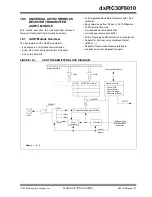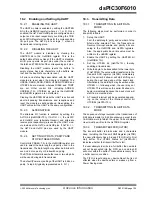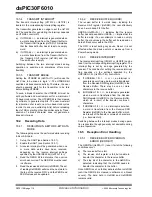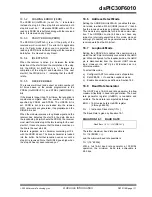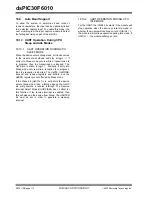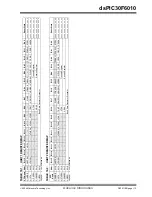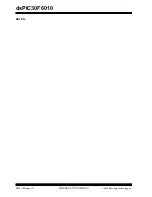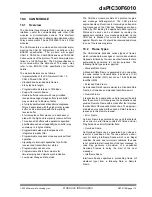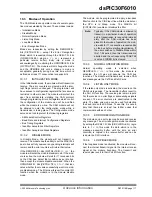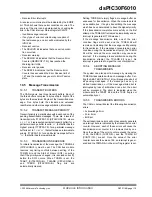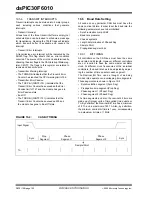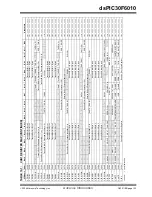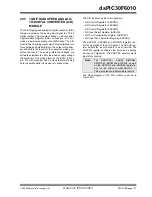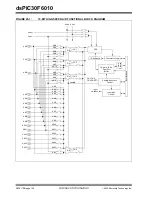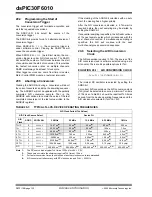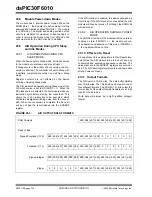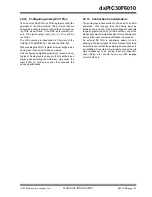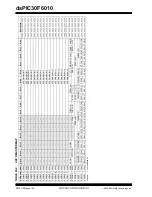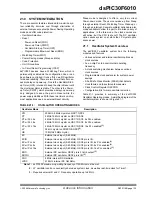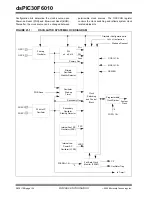
2004 Microchip Technology Inc.
Advance Information
DS70119B-page 121
dsPIC30F6010
19.6.2
PRESCALER SETTING
There is a programmable prescaler, with integral val-
ues ranging from 1 to 64, in addition to a fixed divide-
by-2 for clock generation. The Time Quantum (T
Q
) is a
fixed unit of time derived from the oscillator period, and
is given by Equation 19-1
EQUATION 19-1: TIME QUANTUM FOR
CLOCK GENERATION
19.6.3
PROPAGATION SEGMENT
This part of the bit time is used to compensate physical
delay times within the network. These delay times con-
sist of the signal propagation time on the bus line and
the internal delay time of the nodes. The Propagation
Segment can be programmed from 1 T
Q
to 8 T
Q
by
setting the PRSEG<2:0> bits (CiCFG2<2:0>).
19.6.4
PHASE SEGMENTS
The phase segments are used to optimally locate the
sampling of the received bit within the transmitted bit
time. The sampling point is between Phase1 Seg and
Phase2 Seg. These segments are lengthened or short-
ened by re-synchronization. The end of the Phase1
Seg determines the sampling point within a bit period.
The segment is programmable from 1 T
Q
to 8 T
Q
.
Phase2 Seg provides delay to the next transmitted data
transition. The segment is programmable from 1 T
Q
to
8 T
Q
, or it may be defined to be equal to the greater of
Phase1 Seg or the Information Processing Time
(2 T
Q
). The Phase1 Seg is initialized by setting bits
SEG1PH<2:0> (CiCFG2<5:3>), and Phase2 Seg is ini-
tialized by setting SEG2PH<2:0> (CiCFG2<10:8>).
The following requirement must be fulfilled while setting
the lengths of the Phase Segments:
• Propagation S Phase1 Seg > = Phase2
Seg
19.6.5
SAMPLE POINT
The Sample Point is the point of time at which the bus
level is read and interpreted as the value of that respec-
tive bit. The location is at the end of Phase1 Seg. If the
bit timing is slow and contains many T
Q
, it is possible to
specify multiple sampling of the bus line at the sample
point. The level determined by the CAN bus then corre-
sponds to the result from the majority decision of three
values. The majority samples are taken at the sample
point and twice before with a distance of T
Q
/2. The
CAN module allows the user to chose between sam-
pling three times at the same point or once at the same
point, by setting or clearing the SAM bit (CiCFG2<6>).
Typically, the sampling of the bit should take place at
about 60-70% through the bit time, depending on the
system parameters.
19.6.6
SYNCHRONIZATION
To compensate for phase shifts between the oscillator
frequencies of the different bus stations, each CAN
controller must be able to synchronize to the relevant
signal edge of the incoming signal. When an edge in
the transmitted data is detected, the logic will compare
the location of the edge to the expected time (Synchro-
nous Segment). The circuit will then adjust the values
of Phase1 Seg and Phase2 Seg. There are 2
mechanisms used to synchronize.
19.6.6.1
Hard Synchronization
Hard Synchronization is only done whenever there is a
'recessive' to 'dominant' edge during Bus Idle, indicat-
ing the start of a message. After hard synchronization,
the bit time counters are restarted with the Synchro-
nous Segment. Hard synchronization forces the edge
which has caused the hard synchronization to lie within
the synchronization segment of the restarted bit time. If
a hard synchronization is done, there will not be a
re-synchronization within that bit time.
19.6.6.2
Re-synchronization
As a result of re-synchronization, Phase1 Seg may be
lengthened or Phase2 Seg may be shortened. The
amount of lengthening or shortening of the phase
buffer segment has an upper bound known as the Syn-
chronization Jump Width, and is specified by the
SJW<1:0> bits (CiCFG1<7:6>). The value of the syn-
chronization jump width will be added to Phase1 Seg or
subtracted from Phase2 Seg. The re-synchronization
jump width is programmable between 1 T
Q
and 4 T
Q
.
The following requirement must be fulfilled while setting
the SJW<1:0> bits:
• Phase2 Seg > Synchronization Jump Width
T
Q
= 2 ( BRP<5:0> + 1 ) / F
CAN
Summary of Contents for dsPIC30F6010
Page 12: ...dsPIC30F6010 DS70119B page 10 Advance Information 2004 Microchip Technology Inc NOTES...
Page 32: ...dsPIC30F6010 DS70119B page 30 Advance Information 2004 Microchip Technology Inc NOTES...
Page 38: ...dsPIC30F6010 DS70119B page 36 Advance Information 2004 Microchip Technology Inc NOTES...
Page 50: ...dsPIC30F6010 DS70119B page 48 Advance Information 2004 Microchip Technology Inc NOTES...
Page 68: ...dsPIC30F6010 DS70119B page 66 Advance Information 2004 Microchip Technology Inc NOTES...
Page 72: ...dsPIC30F6010 DS70119B page 70 Advance Information 2004 Microchip Technology Inc NOTES...
Page 76: ...dsPIC30F6010 DS70119B page 74 Advance Information 2004 Microchip Technology Inc NOTES...
Page 86: ...dsPIC30F6010 DS70119B page 84 Advance Information 2004 Microchip Technology Inc NOTES...
Page 108: ...dsPIC30F6010 DS70119B page 106 Advance Information 2004 Microchip Technology Inc NOTES...
Page 116: ...dsPIC30F6010 DS70119B page 114 Advance Information 2004 Microchip Technology Inc NOTES...
Page 128: ...dsPIC30F6010 DS70119B page 126 Advance Information 2004 Microchip Technology Inc NOTES...
Page 150: ...dsPIC30F6010 DS70119B page 148 Advance Information 2004 Microchip Technology Inc NOTES...
Page 164: ...dsPIC30F6010 DS70119B page 162 Advance Information 2004 Microchip Technology Inc NOTES...
Page 208: ...dsPIC30F6010 DS70119B page 206 Advance Information 2004 Microchip Technology Inc NOTES...
Page 220: ...dsPIC30F6010 DS70119B page 220 Advance Information 2004 Microchip Technology Inc NOTES...
Page 221: ...2004 Microchip Technology Inc Advance Information DS70119B page 221 dsPIC30F6010 NOTES...

